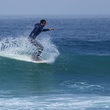more at http://quickfound.net
Surfing at Waikiki Beach, Hawaii, in the 1920s. The surfers include William Kahanamoku, David Kahanamoku, and Dave's dog, "Spot." Re-released in 1965 by Educational Film Exchanges.
see also: Surfing: "Riders of the California Surf" 1947 Color
https://www.youtube.com/watch?v=9_H2cSOMcDo
Public domain film from the Prelinger Archives, slightly cropped to remove uneven edges, with the aspect ratio corrected, and mild video noise reduction applied.
The film was silent. I have added music created by myself using the Reaper Digital Audio Workstation and the Kontakt 5 and Proteus VX VST instrument plugins.
http://creativecommons.org/licenses/by-sa/3.0/
http://en.wikipedia.org/wiki/Surfing
Surfing is a surface water sport in which the wave rider, referred to as a "surfer", rides on the forward face of a moving wave which is usually carrying the surfer towards the shore. Waves suitable for surfing are primarily found in the ocean, but can also be found in lakes or in rivers in the form of a standing wave or tidal bore. However, surfers can also utilize man-made waves such as those from boat wakes and the waves created in artificial wave pools.
The term "surfing" refers to the act of riding a wave, regardless of whether the wave is ridden with a board or without a board, and regardless of the stance used. For instance, the native peoples of the Pacific surfed waves on alaia, paipo, and other such crafts, and did so on their bellies, knees, and feet. However, the modern day definition of surfing most often refers to a surfer riding a wave standing up on a surfboard, and this is also referred to as stand-up surfing. One variety of stand-up surfing is paddle boarding. Another prominent form of surfing in the ocean today is body boarding, when a surfer rides a wave either on the belly, drop knee, or sometimes standing-up on a body board. Other types of surfing include knee boarding, surf matting (riding inflatable mats), foils. Body surfing, where the wave is surfed without a board, using the surfer's own body to catch and ride the wave, is very common and is considered by some to be the purest form of surfing.
Three major subdivisions within standing-up surfing are long boarding, short boarding, and stand up paddle surfing (SUP), and these three have several major differences, including the board design and length, the riding style, and the kind of wave that is ridden...
Origins and history
For centuries surfing was a central part of ancient Polynesian culture. Surfing might have been first observed by Europeans at Tahiti in 1767 by Samuel Wallis and the crew members of the Dolphin who were the first Europeans to visit the island in June 1767. Another candidate is the botanist Joseph Banks being part of the first voyage of James Cook on the HMS Endeavour, who arrived on 10 April 1769 on Tahiti. Lieutenant James King was the first one who wrote about the art of surfing on Hawaii when completing the journals of Captain James Cook upon Cook's death in 1779.
When Mark Twain visited Hawaii in 1866 he wrote,
In one place we came upon a large company of naked natives, of both sexes and all ages, amusing themselves with the national pastime of surf-bathing.
References to surf riding on planks and single canoe hulls are also verified for pre-contact Samoa, where surfing was called fa'ase'e or se'egalu (see Augustin Krämer, The Samoa Islands) and Tonga far pre-dating the practice of surfing by Hawaiians and eastern Polynesians by over a thousand years.
George Freeth (November 8, 1883 -- April 7, 1919) is often credited as being the "Father of Modern Surfing". He is also thought to have been the first modern surfer.
In 1907, the eclectic interests of land baron Henry Huntington brought the ancient art of surfing to the California coast. While on vacation, Huntington had seen Hawaiian boys surfing the island waves. Looking for a way to entice visitors to the area of Redondo Beach, where he had heavily invested in real estate, he hired a young Hawaiian riding surfboards. Freeth decided to revive the art of surfing, but had little success with the huge 16-foot hardwood boards that were popular at that time. When he cut them in half to make them more manageable, he unwittingly created the original "Long board", which made him the talk of the islands. To the delight of visitors, Freeth exhibited his surfing prowess twice a day in front of the Hotel Redondo...










